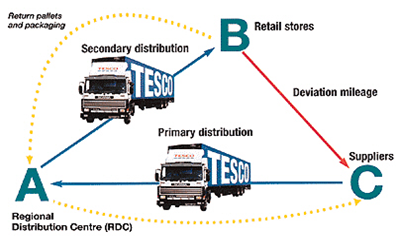Delivery Systems and Models in Supermarket Industry
To meet the high expectations of on-time delivery while keeping the delivery costs low, e-grocers need to use fairly advanced optimization techniques and information technology systems. With every grocery retailer there is a flow of finished goods from its suppliers, then from the company to its customers. Grocery retailers also exchange and receive information which provides valuable data for the system.
These include feedback from the marketplace in the form of customers’ orders, customer reaction, and information on needs and wants; flows of information within the company that provide data in the form of inventory schedules, production schedules and so on as well as orders from the company to outside suppliers’.
From a standpoint the whole company and the market in which it operates can be deemed as a series of linkages and relationships, and the efficiency in which the company operates can be seen to depend on how well these connections work. Having a system that works smoothly at minimum cost, would possibly allow for the company performance to be high. However this is not always the case in practice where it is common to find bottlenecks and poor integration between different parts of this system, leading to disappointing results.
There are various methods and systems that can be implemented by retailers and over the past years the big supermarkets tried to adopt centralised models but where quick to abandon them in the past decade once they realised they would struggle with being efficient. This excludes Ocado which remains at the other end of the spectrum. ‘Ocado maintains that its centralised model will prove more efficient than the supermarkets’ store-picking approach once it achieves a critical mass’. The drawback is that Ocado might incur some difficulties if its tries to implement the hub and spoke system for the entire country. On the other hand Tesco is able to boast of 98 per cent coverage, thanks to its extensive store network where it uses it own Lorries and trucks to collect, transfer and deliver.
A hub-and-spoke is a logistics system. In the middle the system is a data warehouse and around the outside are network data points which allows for different products to be received from different sources, sorted and then delivered. The method been used by various companies in different industries to date but the success rate does vary. The Food Retail companies like Tesco, Asda and Sainsbury have a different delivery system which allows for internet orders to be passed on to local stores where staff are able to choose or select from the range and if not pick an alternative. The items selected are then packed and delivered to the customer’s chosen address. In addition the customer is allowed to return a substituted item if it is deemed unacceptable.
The benefit of this system is that these grocery retailers are able to maintain a closer relationship with their consumers through the familiarisation between the delivery driver and customer. This allows a level of trust and confidence in the service whilst making a profit with delivery charges. For retailers owning and operating their own delivery system, it is important to have delivery time windows met and assigned. Complications arise with issues such as high demand for particular time slots, travel time uncertainties, and short time windows.
Routes are built as customers’ place their orders. A customer places an order on the website or the chosen retailer and selects a delivery time slot. At this point a system works to locate where the customer is and shows them the slots available whether it be 30 minute or 1 hour slots. The system points out the slots available for the customer whilst identifying whether there are other orders in the same area as well as if the retailer has the capacity to deal with the given order at the given time. As orders are processed, routes are broken apart and orders are met. However the key at the end of the day is to ensure that the retailer works within their capacity, that equipment is utilised and customer expectations are met.
Grocery retailers have to determine how customer needs regarding delivery time fits into their schedule allowing them to identify delivery time slots are available. With this in mind concern remains on how to manage time slots appropriately for the current customer as well as a potential customers. Therefore the main goal is having an efficient and effective level of capacity. This goal has meant that supermarkets’ remain focused on establishing e-business systems with new competitive processes in the food retailing industry applying consumer-driven innovation networks.

